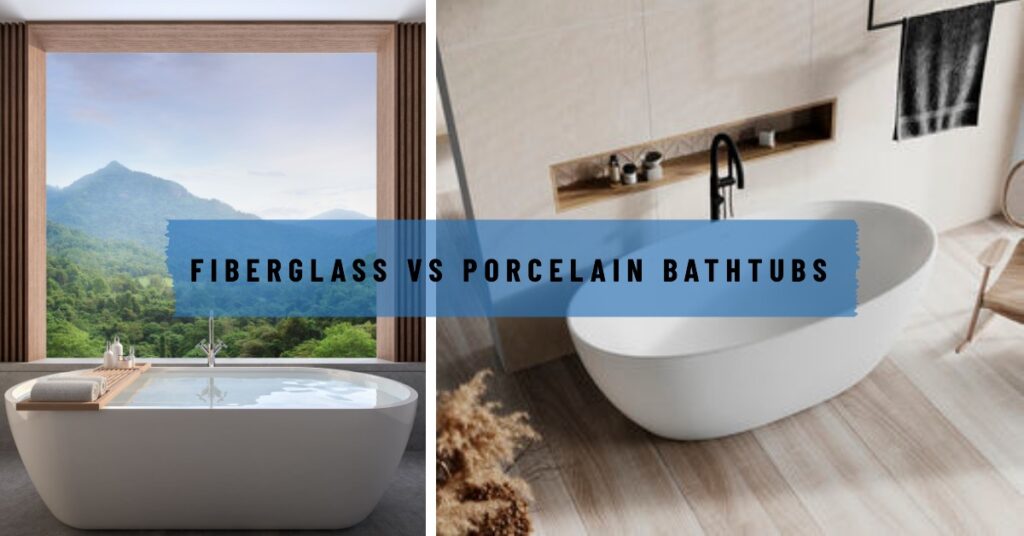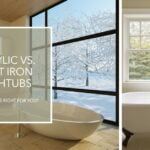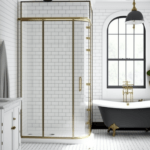
Are you planning to renovate your bathroom or replace your old bathtub? If so, you might be wondering whether to go for a fiberglass or porcelain tub. Both materials have their advantages and disadvantages, and choosing the right one can make a big difference in terms of durability, maintenance, and cost. In this article, we will compare fiberglass and porcelain tubs based on several criteria, such as price, weight, durability, comfort, and ease of cleaning, to help you make an informed decision.
Quick Comparison
| Characteristic | Fiberglass Tub | Porcelain Tub |
|---|---|---|
| Cost | Less expensive | More expensive |
| Durability | Less durable, prone to cracking and fading | More durable, resistant to chipping and fading |
| Comfort | Less comfortable, may flex or creak | More comfortable, retains heat well |
| Maintenance | Requires less maintenance, easy to clean | Requires more maintenance, may require professional cleaning |
| Installation | Easier to install, lighter weight | Harder to install, heavier weight |
| Hygiene | Less hygienic, may stain or discolor | More hygienic, resists staining and discoloration |
| Style | Wide range of colors and shapes available | Classic and elegant, limited range of colors and shapes |
Finding the Best Cast Iron Bathtub: Are you looking for the best cast iron bathtub for your bathroom? Look no further than our ultimate guide to finding the best cast iron bathtub.
What is a fiberglass tub?
A fiberglass tub is a bathtub made of reinforced plastic that is coated with a layer of polyester or acrylic resin. The fiberglass material is lightweight, strong, and affordable, which makes it a popular choice for homeowners. Fiberglass tubs come in various shapes and sizes, from simple rectangular to oval or corner designs. They are easy to install, and you can choose from a wide range of colors and patterns to match your bathroom decor.
What is a porcelain tub?
A porcelain tub, also known as a ceramic tub, is made of a cast iron or steel frame covered with a layer of porcelain enamel. Porcelain is a type of glass fused to metal at high temperatures, creating a smooth and durable surface that resists chipping, scratching, and staining. Porcelain tubs have a classic and elegant look that never goes out of style. They come in various shapes and sizes, from traditional clawfoot to modern alcove designs.
Price comparison
When it comes to price, fiberglass tubs are generally cheaper than porcelain tubs. The average cost of a fiberglass tub ranges from $200 to $1,000, depending on the size and features. In contrast, the average cost of a porcelain tub ranges from $500 to $2,000 or more, depending on the brand and style. However, keep in mind that the cost of installation and plumbing can add up to the total price, regardless of the material.
Weight comparison
Fiberglass tubs are much lighter than porcelain tubs, which can make a significant difference in installation and transportation. A typical fiberglass tub weighs between 45 and 100 pounds, while a porcelain tub can weigh up to 400 pounds or more. The weight of a bathtub also affects the load-bearing capacity of your bathroom floor. If you have a second-floor bathroom or an older house, you may need to reinforce the floor to support a heavy tub.
How Much Does a Cast Iron Tub Weigh?: Before you purchase a cast iron tub, make sure you know how much it weighs! Check out our article on how much does a cast iron tub weigh? to find out.
Durability comparison
Both fiberglass and porcelain tubs are durable materials that can last for many years with proper care. However, they have different strengths and weaknesses in terms of resistance to impact, heat, and chemicals. Fiberglass tubs are more resistant to cracking and flexing than porcelain tubs, but they are also more prone to fading, yellowing, and staining. Porcelain tubs are more resistant to chipping, scratching, and discoloration than fiberglass tubs, but they can also crack if hit with a hard object or exposed to extreme temperatures. Porcelain tubs are also more hygienic than fiberglass tubs, as they don’t absorb bacteria or odors. However, they require more maintenance to keep the enamel finish intact, as abrasive cleaners or rough surfaces can damage the surface.
Comfort comparison
The comfort level of a bathtub depends on several factors, such as size, shape, depth, and slope. Fiberglass tubs are generally more comfortable than porcelain tubs, as they are softer and warmer to the touch. They also come in various ergonomic designs, such as lumbar support, armrests, and slip-resistant bottoms, to provide a better bathing experience. Porcelain tubs, on the other hand, are more rigid and cold to the touch, which can be uncomfortable for some users. They also have less variety in terms of shape and depth, as they are often designed for a classic look rather than functionality.
Cleaning comparison
Keeping your bathtub clean is essential for maintaining its appearance and hygiene. Fiberglass tubs are easier to clean than porcelain tubs, as they have a non-porous surface that resists mold, mildew, and soap scum. You can use a mild detergent or a baking soda solution to clean a fiberglass tub without damaging the surface. Porcelain tubs, however, require more attention and care, as the enamel finish can chip or scratch if you use abrasive cleaners or tools. You need to use a non-abrasive cleaner, such as vinegar or baking soda, to remove stains or soap scum from a porcelain tub. You also need to avoid using hard water or acidic solutions that can etch the surface or cause discoloration.
Installation comparison
Installing a bathtub can be a DIY project or require professional help, depending on your skills and experience. Fiberglass tubs are easier to install than porcelain tubs, as they are lightweight and come in one piece or several sections that you can assemble on site. You can also install a fiberglass tub on a variety of surfaces, such as concrete, wood, or tile, without the need for extra reinforcement. Porcelain tubs, however, are more challenging to install, as they are heavy and fragile. You need to hire a professional plumber or contractor to install a porcelain tub, as they require a level and sturdy base to prevent cracking or shifting.
Maintenance comparison
Maintaining your bathtub in good condition requires regular cleaning and inspection. Fiberglass tubs are low-maintenance, as they don’t require sealing or refinishing to stay in good shape. However, they can develop cracks or leaks if they are exposed to excessive weight or pressure. Porcelain tubs, on the other hand, require more maintenance, as the enamel finish can wear off or chip over time. You may need to refinish a porcelain tub every 10 to 15 years to restore its shine and protect it from corrosion or rust.
Acrylic vs. Cast Iron Bathtubs: Not sure whether to choose an acrylic or cast iron bathtub for your bathroom? Our guide to acrylic vs. cast iron bathtubs can help you make an informed decision.
Environmental impact
Choosing a sustainable and eco-friendly bathtub can help reduce your carbon footprint and save natural resources. Fiberglass tubs are more eco-friendly than porcelain tubs, as they are made of recycled materials and can be recycled again at the end of their life cycle. They also require less energy and water to manufacture and transport, which reduces their environmental impact. Porcelain tubs, however, are made of mined materials, such as iron and clay, that require a lot of energy and resources to extract and refine. They also have a shorter lifespan than fiberglass tubs and can end up in landfills, where they don’t decompose.
Which one to choose?
Choosing the right bathtub depends on your budget, style, functionality, and personal preference. If you are looking for a budget-friendly and lightweight option that is easy to install and maintain, a fiberglass tub may be a good choice for you. It also offers a wider range of sizes, shapes, and colors, which allows you to customize your bathroom to your liking. However, if you prioritize durability, comfort, and hygiene, a porcelain tub may be a better option for you. It also adds value and elegance to your bathroom, especially if you prefer a classic or vintage style.
Pros and Cons of Freestanding Tubs: If you’re considering a freestanding tub for your bathroom, be sure to check out our guide to the pros and cons of freestanding tubs.
Conclusion
In summary, the decision between a fiberglass tub and a porcelain tub depends on several factors, such as cost, maintenance, comfort, cleaning, installation, and environmental impact. While fiberglass tubs are cheaper, easier to install, and require less maintenance, they may not be as durable, comfortable, or hygienic as porcelain tubs. On the other hand, porcelain tubs are more expensive, harder to install, and require more maintenance, but they offer better durability, comfort, and hygiene. Ultimately, it’s up to you to weigh the pros and cons and choose the bathtub that suits your needs and preferences.
FAQs
Yes, fiberglass tubs are prone to cracking over time.
Porcelain tubs can last for decades with proper care.
No, porcelain tubs are easy to clean and maintain.
Yes, fiberglass tubs are easy to install and can be done by a DIYer.
No, bleach can damage the surface of the fiberglass tub. Use a non-abrasive cleanser instead.
Fiberglass tubs can last up to 20 years with proper care and maintenance. However, they may develop cracks or leaks if they are exposed to excessive weight or pressure.
Porcelain tubs are not as eco-friendly as fiberglass tubs, as they are made of mined materials that require a lot of energy and resources to extract and refine. However, you can still reduce their environmental impact by choosing a high-quality and long-lasting product and recycling it at the end of its life cycle.






